Competency Demonstration Report: Hybrid Agricultural Robot Design
VerifiedAdded on 2023/05/28
|10
|1608
|325
Report
AI Summary
This report details the design and implementation of a hybrid agricultural robot, focusing on the development of a robotic arm for harvesting heavy fruits. The project aimed to create a functional and operable robot capable of overcoming obstacles like leaves and branches. The student's responsibilities included prototype designing, control algorithm development, and team management. The report covers the kinematics model, control strategies using PID and fuzzy controllers, and the challenges faced, such as variable loads. The project involved a team with a supervisor, leader, and team members, and the student was responsible for overseeing the project's progress and ensuring the team met its objectives. The report highlights the innovative approach of integrating fuzzy and proportional controllers to mitigate the effects of variable loads, differentiating the robot from existing serial-type agricultural robots.
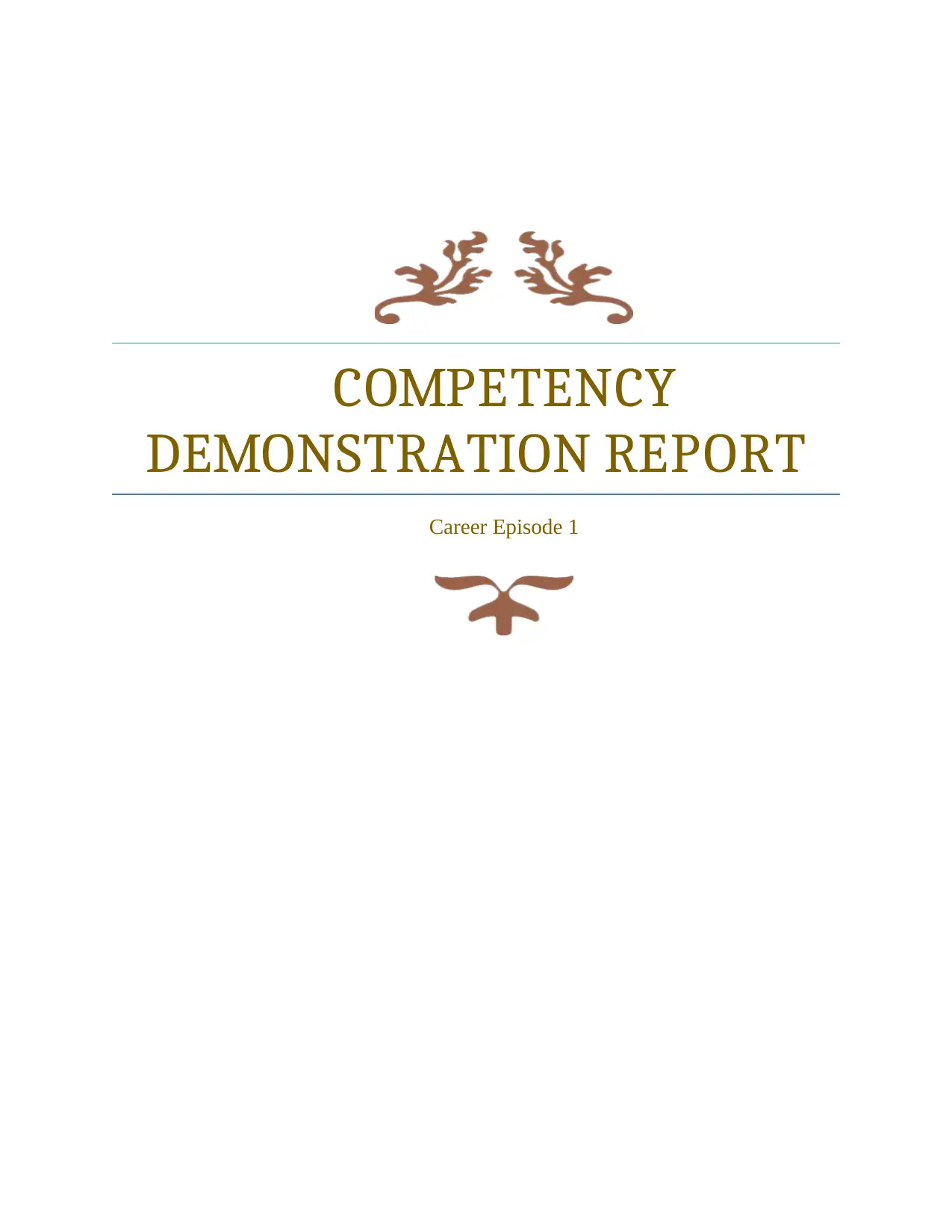
COMPETENCY
DEMONSTRATION REPORT
Career Episode 1
DEMONSTRATION REPORT
Career Episode 1
Paraphrase This Document
Need a fresh take? Get an instant paraphrase of this document with our AI Paraphraser
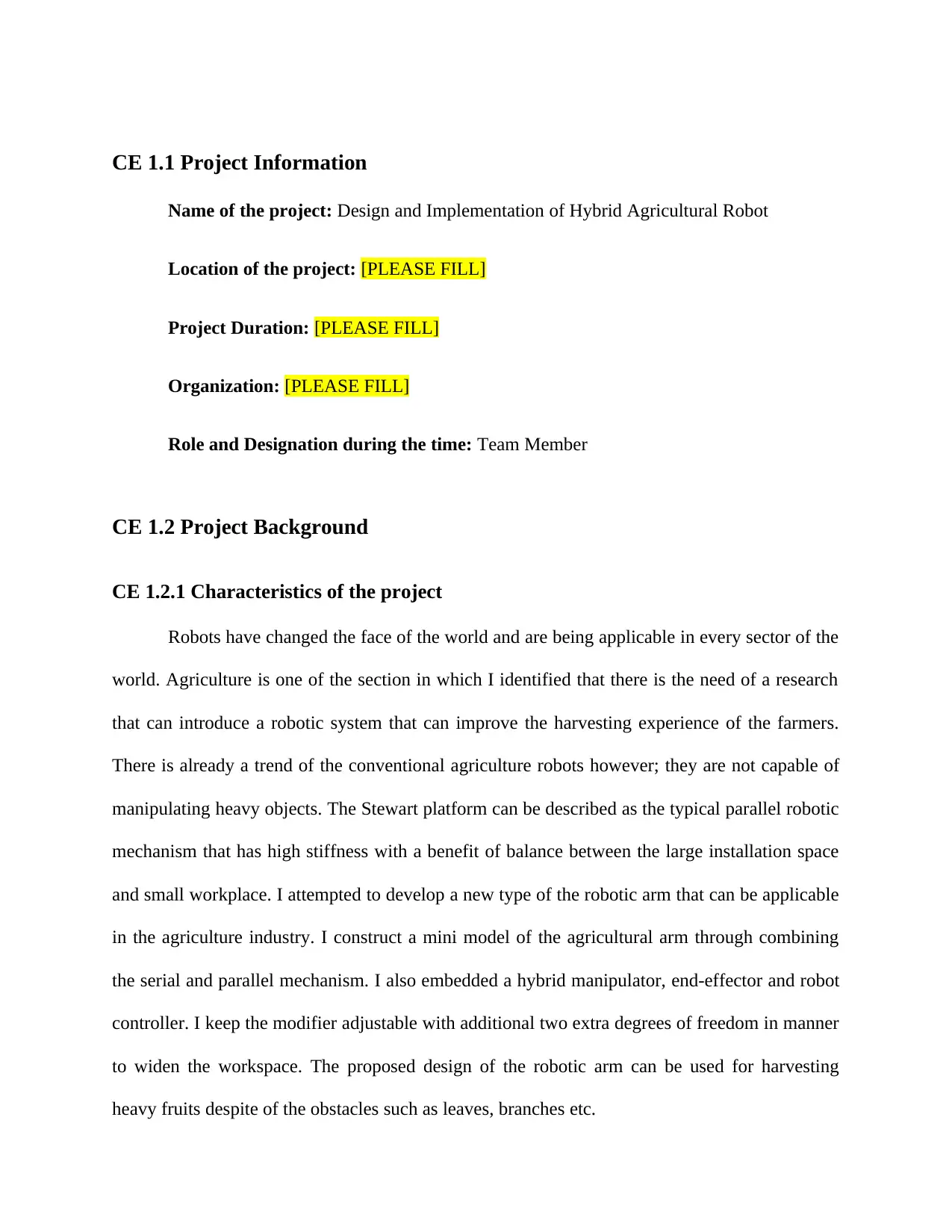
CE 1.1 Project Information
Name of the project: Design and Implementation of Hybrid Agricultural Robot
Location of the project: [PLEASE FILL]
Project Duration: [PLEASE FILL]
Organization: [PLEASE FILL]
Role and Designation during the time: Team Member
CE 1.2 Project Background
CE 1.2.1 Characteristics of the project
Robots have changed the face of the world and are being applicable in every sector of the
world. Agriculture is one of the section in which I identified that there is the need of a research
that can introduce a robotic system that can improve the harvesting experience of the farmers.
There is already a trend of the conventional agriculture robots however; they are not capable of
manipulating heavy objects. The Stewart platform can be described as the typical parallel robotic
mechanism that has high stiffness with a benefit of balance between the large installation space
and small workplace. I attempted to develop a new type of the robotic arm that can be applicable
in the agriculture industry. I construct a mini model of the agricultural arm through combining
the serial and parallel mechanism. I also embedded a hybrid manipulator, end-effector and robot
controller. I keep the modifier adjustable with additional two extra degrees of freedom in manner
to widen the workspace. The proposed design of the robotic arm can be used for harvesting
heavy fruits despite of the obstacles such as leaves, branches etc.
Name of the project: Design and Implementation of Hybrid Agricultural Robot
Location of the project: [PLEASE FILL]
Project Duration: [PLEASE FILL]
Organization: [PLEASE FILL]
Role and Designation during the time: Team Member
CE 1.2 Project Background
CE 1.2.1 Characteristics of the project
Robots have changed the face of the world and are being applicable in every sector of the
world. Agriculture is one of the section in which I identified that there is the need of a research
that can introduce a robotic system that can improve the harvesting experience of the farmers.
There is already a trend of the conventional agriculture robots however; they are not capable of
manipulating heavy objects. The Stewart platform can be described as the typical parallel robotic
mechanism that has high stiffness with a benefit of balance between the large installation space
and small workplace. I attempted to develop a new type of the robotic arm that can be applicable
in the agriculture industry. I construct a mini model of the agricultural arm through combining
the serial and parallel mechanism. I also embedded a hybrid manipulator, end-effector and robot
controller. I keep the modifier adjustable with additional two extra degrees of freedom in manner
to widen the workspace. The proposed design of the robotic arm can be used for harvesting
heavy fruits despite of the obstacles such as leaves, branches etc.
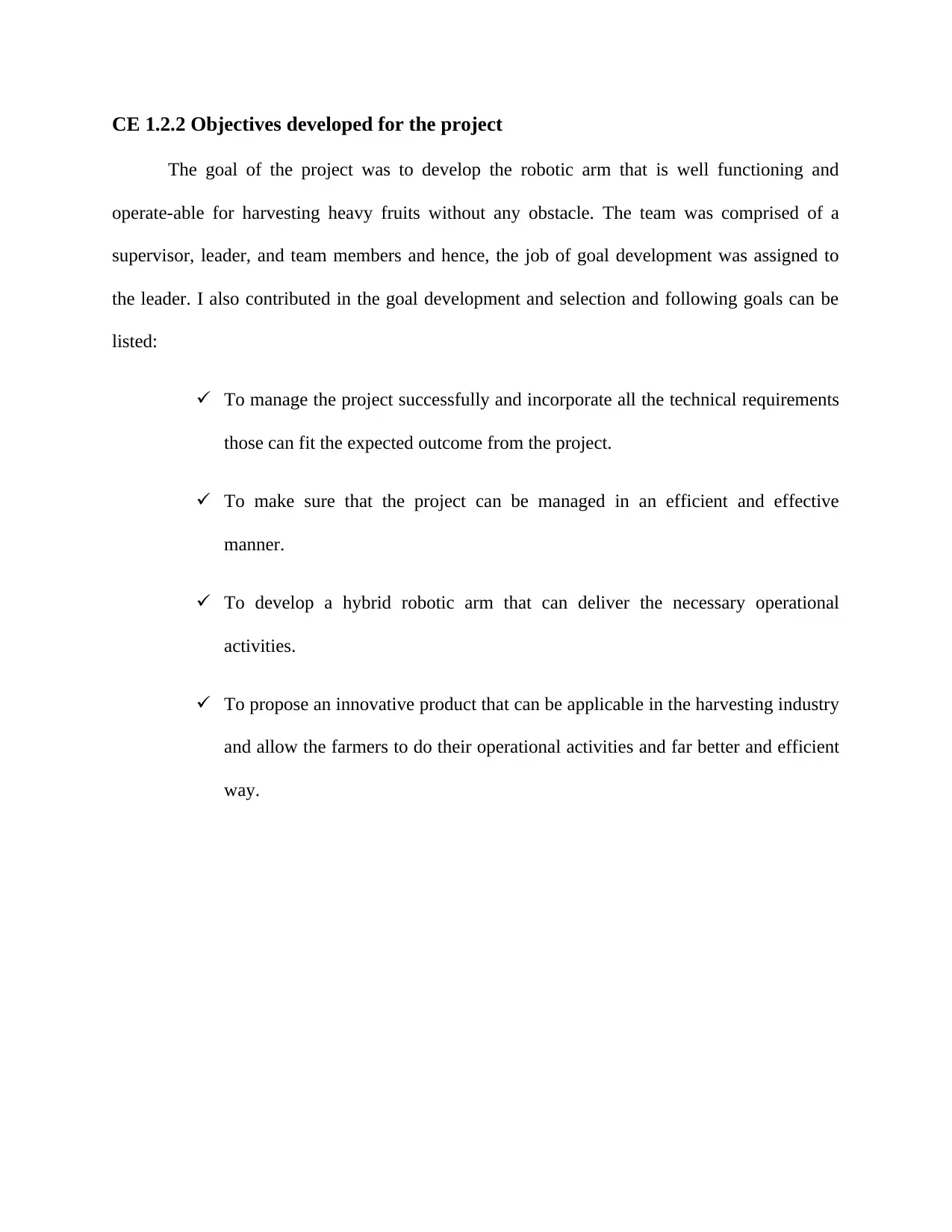
CE 1.2.2 Objectives developed for the project
The goal of the project was to develop the robotic arm that is well functioning and
operate-able for harvesting heavy fruits without any obstacle. The team was comprised of a
supervisor, leader, and team members and hence, the job of goal development was assigned to
the leader. I also contributed in the goal development and selection and following goals can be
listed:
To manage the project successfully and incorporate all the technical requirements
those can fit the expected outcome from the project.
To make sure that the project can be managed in an efficient and effective
manner.
To develop a hybrid robotic arm that can deliver the necessary operational
activities.
To propose an innovative product that can be applicable in the harvesting industry
and allow the farmers to do their operational activities and far better and efficient
way.
The goal of the project was to develop the robotic arm that is well functioning and
operate-able for harvesting heavy fruits without any obstacle. The team was comprised of a
supervisor, leader, and team members and hence, the job of goal development was assigned to
the leader. I also contributed in the goal development and selection and following goals can be
listed:
To manage the project successfully and incorporate all the technical requirements
those can fit the expected outcome from the project.
To make sure that the project can be managed in an efficient and effective
manner.
To develop a hybrid robotic arm that can deliver the necessary operational
activities.
To propose an innovative product that can be applicable in the harvesting industry
and allow the farmers to do their operational activities and far better and efficient
way.
⊘ This is a preview!⊘
Do you want full access?
Subscribe today to unlock all pages.

Trusted by 1+ million students worldwide
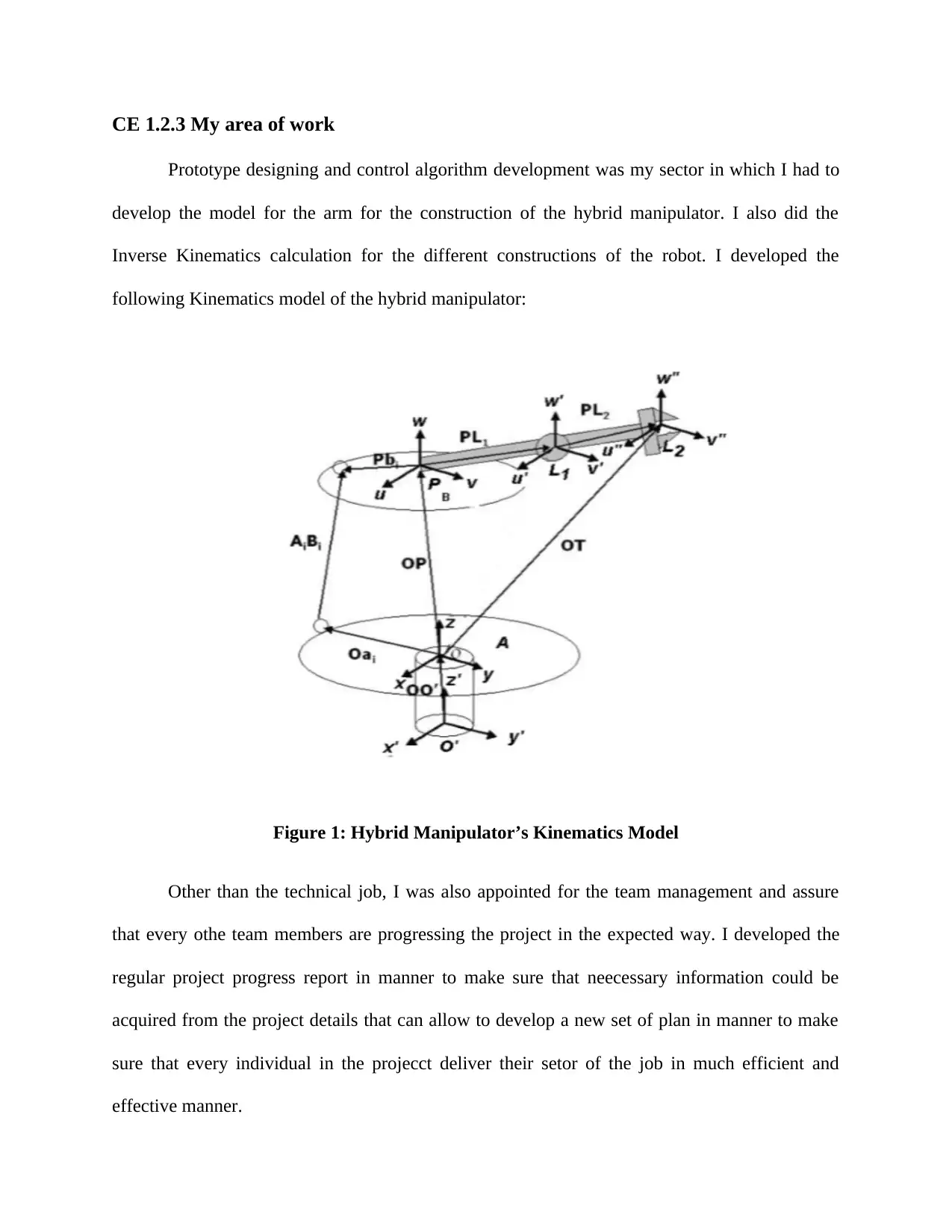
CE 1.2.3 My area of work
Prototype designing and control algorithm development was my sector in which I had to
develop the model for the arm for the construction of the hybrid manipulator. I also did the
Inverse Kinematics calculation for the different constructions of the robot. I developed the
following Kinematics model of the hybrid manipulator:
Figure 1: Hybrid Manipulator’s Kinematics Model
Other than the technical job, I was also appointed for the team management and assure
that every othe team members are progressing the project in the expected way. I developed the
regular project progress report in manner to make sure that neecessary information could be
acquired from the project details that can allow to develop a new set of plan in manner to make
sure that every individual in the projecct deliver their setor of the job in much efficient and
effective manner.
Prototype designing and control algorithm development was my sector in which I had to
develop the model for the arm for the construction of the hybrid manipulator. I also did the
Inverse Kinematics calculation for the different constructions of the robot. I developed the
following Kinematics model of the hybrid manipulator:
Figure 1: Hybrid Manipulator’s Kinematics Model
Other than the technical job, I was also appointed for the team management and assure
that every othe team members are progressing the project in the expected way. I developed the
regular project progress report in manner to make sure that neecessary information could be
acquired from the project details that can allow to develop a new set of plan in manner to make
sure that every individual in the projecct deliver their setor of the job in much efficient and
effective manner.
Paraphrase This Document
Need a fresh take? Get an instant paraphrase of this document with our AI Paraphraser
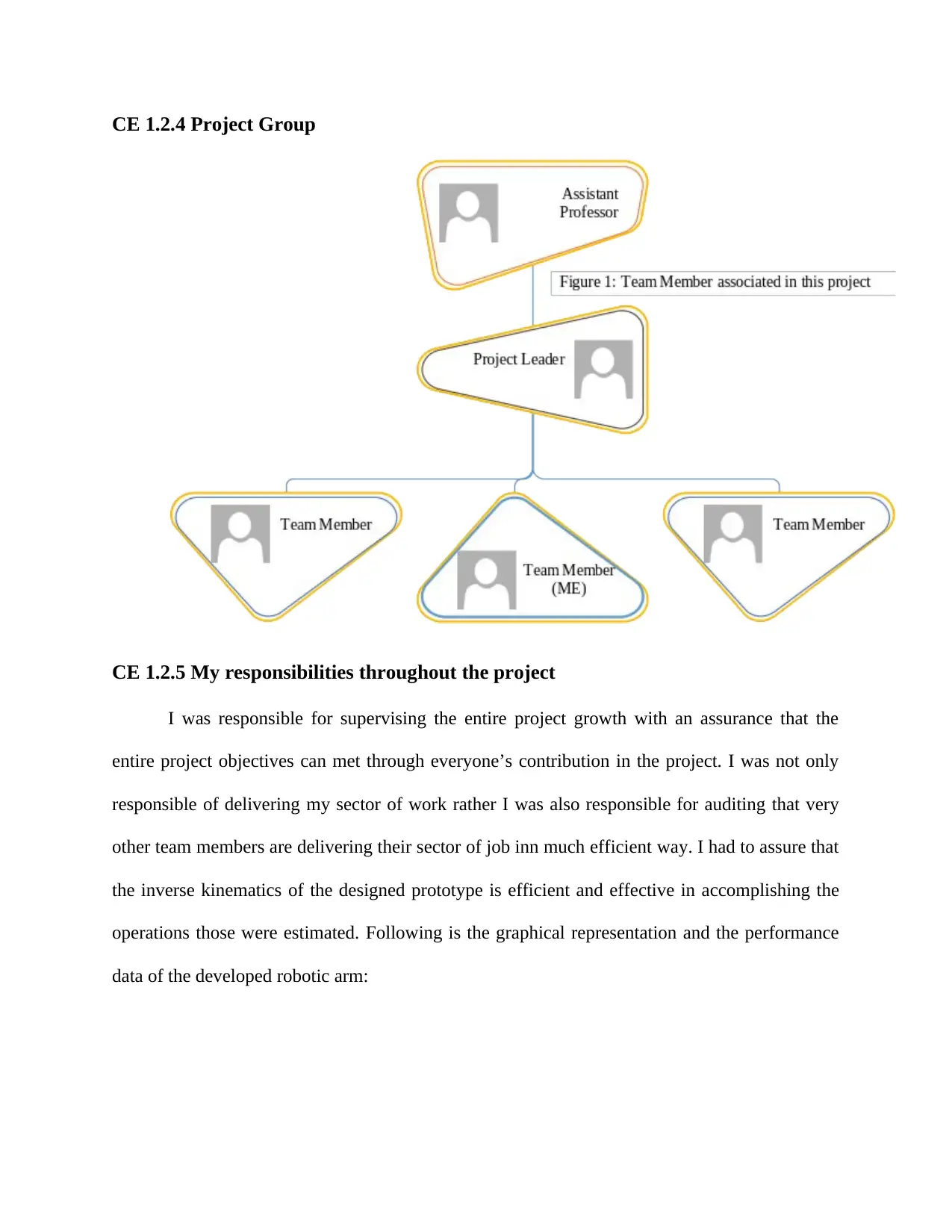
CE 1.2.4 Project Group
CE 1.2.5 My responsibilities throughout the project
I was responsible for supervising the entire project growth with an assurance that the
entire project objectives can met through everyone’s contribution in the project. I was not only
responsible of delivering my sector of work rather I was also responsible for auditing that very
other team members are delivering their sector of job inn much efficient way. I had to assure that
the inverse kinematics of the designed prototype is efficient and effective in accomplishing the
operations those were estimated. Following is the graphical representation and the performance
data of the developed robotic arm:
CE 1.2.5 My responsibilities throughout the project
I was responsible for supervising the entire project growth with an assurance that the
entire project objectives can met through everyone’s contribution in the project. I was not only
responsible of delivering my sector of work rather I was also responsible for auditing that very
other team members are delivering their sector of job inn much efficient way. I had to assure that
the inverse kinematics of the designed prototype is efficient and effective in accomplishing the
operations those were estimated. Following is the graphical representation and the performance
data of the developed robotic arm:

Figure 2: Performance of the Proportional Control
Experiment Desired position and orientation
x y Z ȥ ș ĭ
1. -100 551.5 1031.5 0 10 10
2. 100 551.5 1031.5 0 0 0
3. 100 571 1031.5 10 0 10
4. 100 521 1131.5 10 10 10
5. 100 571 1131.5 10 0 0
Experiment Actual position and orientation
x y z ȥ ș ĭ
1. -100.5 551.2 1031 0.1 10.1 10.1
2. 99.7 551 1031.4 -0.1 0.1 0.1
3. 100.2 571.3 1031.7 9.8 0.1 9.9
4. 100.8 521.3 1131.9 10.1 10.2 9.9
Experiment Desired position and orientation
x y Z ȥ ș ĭ
1. -100 551.5 1031.5 0 10 10
2. 100 551.5 1031.5 0 0 0
3. 100 571 1031.5 10 0 10
4. 100 521 1131.5 10 10 10
5. 100 571 1131.5 10 0 0
Experiment Actual position and orientation
x y z ȥ ș ĭ
1. -100.5 551.2 1031 0.1 10.1 10.1
2. 99.7 551 1031.4 -0.1 0.1 0.1
3. 100.2 571.3 1031.7 9.8 0.1 9.9
4. 100.8 521.3 1131.9 10.1 10.2 9.9
⊘ This is a preview!⊘
Do you want full access?
Subscribe today to unlock all pages.

Trusted by 1+ million students worldwide
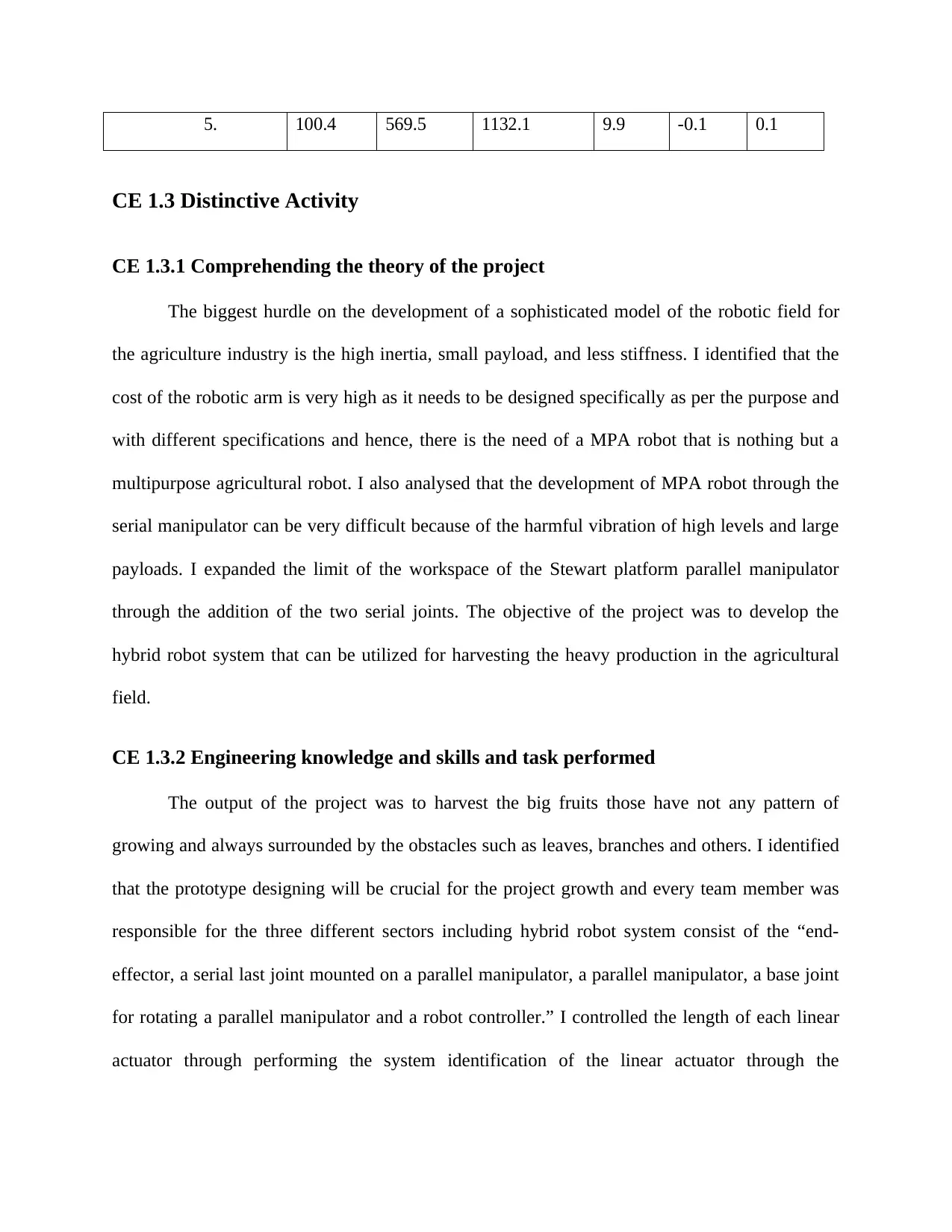
5. 100.4 569.5 1132.1 9.9 -0.1 0.1
CE 1.3 Distinctive Activity
CE 1.3.1 Comprehending the theory of the project
The biggest hurdle on the development of a sophisticated model of the robotic field for
the agriculture industry is the high inertia, small payload, and less stiffness. I identified that the
cost of the robotic arm is very high as it needs to be designed specifically as per the purpose and
with different specifications and hence, there is the need of a MPA robot that is nothing but a
multipurpose agricultural robot. I also analysed that the development of MPA robot through the
serial manipulator can be very difficult because of the harmful vibration of high levels and large
payloads. I expanded the limit of the workspace of the Stewart platform parallel manipulator
through the addition of the two serial joints. The objective of the project was to develop the
hybrid robot system that can be utilized for harvesting the heavy production in the agricultural
field.
CE 1.3.2 Engineering knowledge and skills and task performed
The output of the project was to harvest the big fruits those have not any pattern of
growing and always surrounded by the obstacles such as leaves, branches and others. I identified
that the prototype designing will be crucial for the project growth and every team member was
responsible for the three different sectors including hybrid robot system consist of the “end-
effector, a serial last joint mounted on a parallel manipulator, a parallel manipulator, a base joint
for rotating a parallel manipulator and a robot controller.” I controlled the length of each linear
actuator through performing the system identification of the linear actuator through the
CE 1.3 Distinctive Activity
CE 1.3.1 Comprehending the theory of the project
The biggest hurdle on the development of a sophisticated model of the robotic field for
the agriculture industry is the high inertia, small payload, and less stiffness. I identified that the
cost of the robotic arm is very high as it needs to be designed specifically as per the purpose and
with different specifications and hence, there is the need of a MPA robot that is nothing but a
multipurpose agricultural robot. I also analysed that the development of MPA robot through the
serial manipulator can be very difficult because of the harmful vibration of high levels and large
payloads. I expanded the limit of the workspace of the Stewart platform parallel manipulator
through the addition of the two serial joints. The objective of the project was to develop the
hybrid robot system that can be utilized for harvesting the heavy production in the agricultural
field.
CE 1.3.2 Engineering knowledge and skills and task performed
The output of the project was to harvest the big fruits those have not any pattern of
growing and always surrounded by the obstacles such as leaves, branches and others. I identified
that the prototype designing will be crucial for the project growth and every team member was
responsible for the three different sectors including hybrid robot system consist of the “end-
effector, a serial last joint mounted on a parallel manipulator, a parallel manipulator, a base joint
for rotating a parallel manipulator and a robot controller.” I controlled the length of each linear
actuator through performing the system identification of the linear actuator through the
Paraphrase This Document
Need a fresh take? Get an instant paraphrase of this document with our AI Paraphraser

application of the Impulse Response Data Method. The gathered system transfer function can be
represented in the following equation:
For the control and algorithm used in the project, I took the following initiatives:
I chose the following rule base of the actuator control system G:
Error ( E E ( n ) E ( n 1) )
Slow Medium Fast
Error ( E ) Small Low Very low Very low
Middle High Midterm Low
represented in the following equation:
For the control and algorithm used in the project, I took the following initiatives:
I chose the following rule base of the actuator control system G:
Error ( E E ( n ) E ( n 1) )
Slow Medium Fast
Error ( E ) Small Low Very low Very low
Middle High Midterm Low
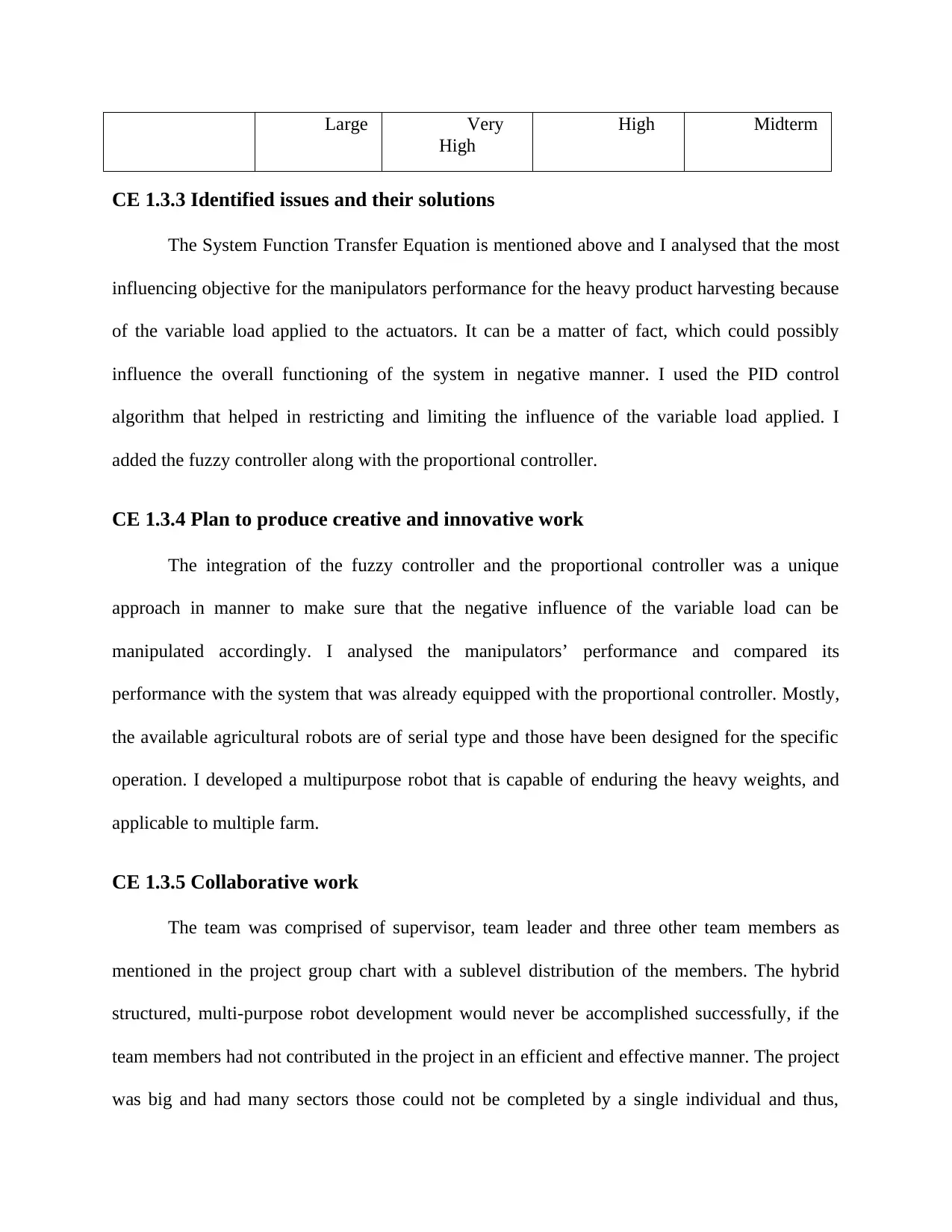
Large Very
High
High Midterm
CE 1.3.3 Identified issues and their solutions
The System Function Transfer Equation is mentioned above and I analysed that the most
influencing objective for the manipulators performance for the heavy product harvesting because
of the variable load applied to the actuators. It can be a matter of fact, which could possibly
influence the overall functioning of the system in negative manner. I used the PID control
algorithm that helped in restricting and limiting the influence of the variable load applied. I
added the fuzzy controller along with the proportional controller.
CE 1.3.4 Plan to produce creative and innovative work
The integration of the fuzzy controller and the proportional controller was a unique
approach in manner to make sure that the negative influence of the variable load can be
manipulated accordingly. I analysed the manipulators’ performance and compared its
performance with the system that was already equipped with the proportional controller. Mostly,
the available agricultural robots are of serial type and those have been designed for the specific
operation. I developed a multipurpose robot that is capable of enduring the heavy weights, and
applicable to multiple farm.
CE 1.3.5 Collaborative work
The team was comprised of supervisor, team leader and three other team members as
mentioned in the project group chart with a sublevel distribution of the members. The hybrid
structured, multi-purpose robot development would never be accomplished successfully, if the
team members had not contributed in the project in an efficient and effective manner. The project
was big and had many sectors those could not be completed by a single individual and thus,
High
High Midterm
CE 1.3.3 Identified issues and their solutions
The System Function Transfer Equation is mentioned above and I analysed that the most
influencing objective for the manipulators performance for the heavy product harvesting because
of the variable load applied to the actuators. It can be a matter of fact, which could possibly
influence the overall functioning of the system in negative manner. I used the PID control
algorithm that helped in restricting and limiting the influence of the variable load applied. I
added the fuzzy controller along with the proportional controller.
CE 1.3.4 Plan to produce creative and innovative work
The integration of the fuzzy controller and the proportional controller was a unique
approach in manner to make sure that the negative influence of the variable load can be
manipulated accordingly. I analysed the manipulators’ performance and compared its
performance with the system that was already equipped with the proportional controller. Mostly,
the available agricultural robots are of serial type and those have been designed for the specific
operation. I developed a multipurpose robot that is capable of enduring the heavy weights, and
applicable to multiple farm.
CE 1.3.5 Collaborative work
The team was comprised of supervisor, team leader and three other team members as
mentioned in the project group chart with a sublevel distribution of the members. The hybrid
structured, multi-purpose robot development would never be accomplished successfully, if the
team members had not contributed in the project in an efficient and effective manner. The project
was big and had many sectors those could not be completed by a single individual and thus,
⊘ This is a preview!⊘
Do you want full access?
Subscribe today to unlock all pages.

Trusted by 1+ million students worldwide
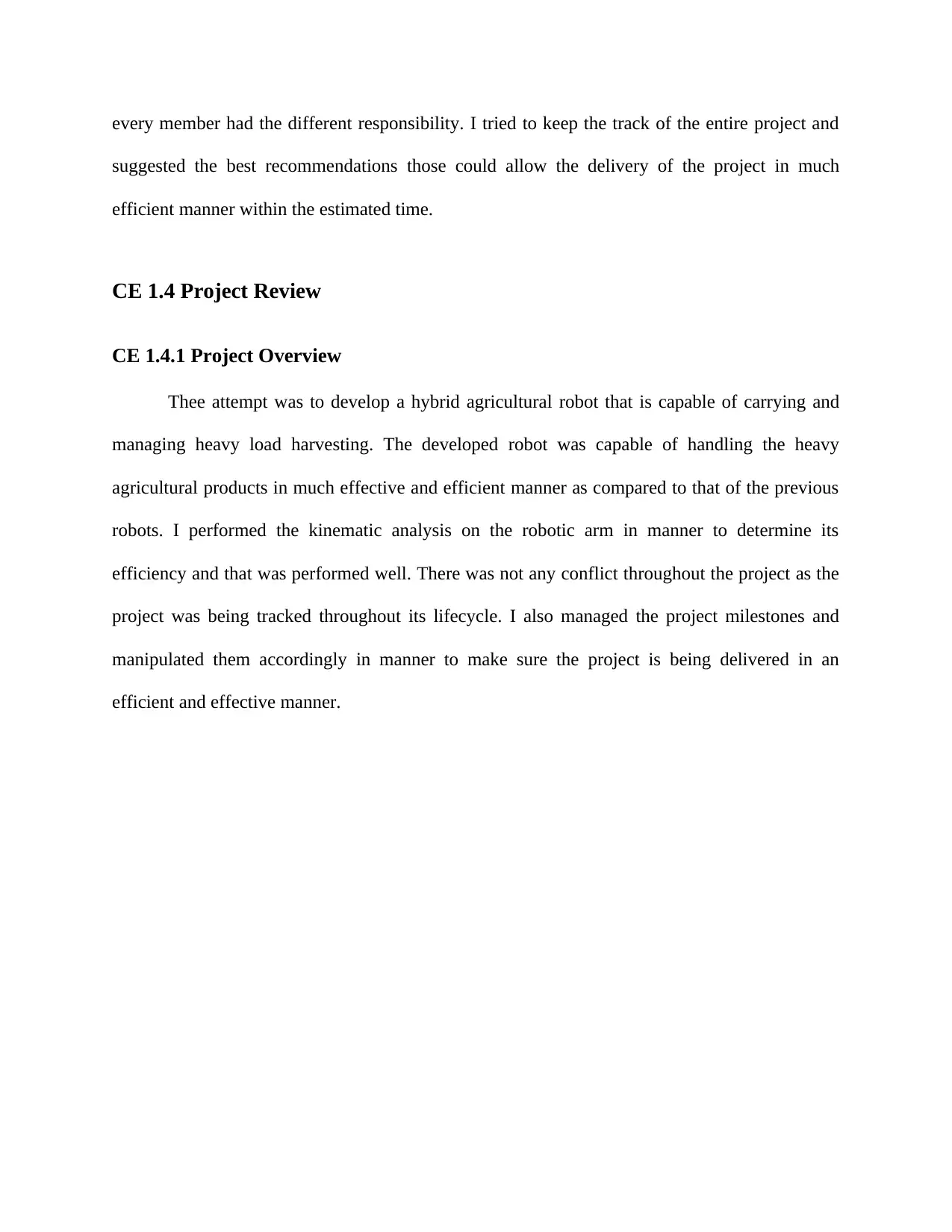
every member had the different responsibility. I tried to keep the track of the entire project and
suggested the best recommendations those could allow the delivery of the project in much
efficient manner within the estimated time.
CE 1.4 Project Review
CE 1.4.1 Project Overview
Thee attempt was to develop a hybrid agricultural robot that is capable of carrying and
managing heavy load harvesting. The developed robot was capable of handling the heavy
agricultural products in much effective and efficient manner as compared to that of the previous
robots. I performed the kinematic analysis on the robotic arm in manner to determine its
efficiency and that was performed well. There was not any conflict throughout the project as the
project was being tracked throughout its lifecycle. I also managed the project milestones and
manipulated them accordingly in manner to make sure the project is being delivered in an
efficient and effective manner.
suggested the best recommendations those could allow the delivery of the project in much
efficient manner within the estimated time.
CE 1.4 Project Review
CE 1.4.1 Project Overview
Thee attempt was to develop a hybrid agricultural robot that is capable of carrying and
managing heavy load harvesting. The developed robot was capable of handling the heavy
agricultural products in much effective and efficient manner as compared to that of the previous
robots. I performed the kinematic analysis on the robotic arm in manner to determine its
efficiency and that was performed well. There was not any conflict throughout the project as the
project was being tracked throughout its lifecycle. I also managed the project milestones and
manipulated them accordingly in manner to make sure the project is being delivered in an
efficient and effective manner.
1 out of 10
Related Documents
Your All-in-One AI-Powered Toolkit for Academic Success.
+13062052269
info@desklib.com
Available 24*7 on WhatsApp / Email
![[object Object]](/_next/static/media/star-bottom.7253800d.svg)
Unlock your academic potential
Copyright © 2020–2025 A2Z Services. All Rights Reserved. Developed and managed by ZUCOL.





